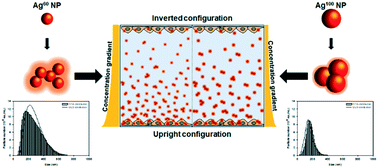当前位置:
X-MOL 学术
›
Environ. Sci.: Nano
›
论文详情
Our official English website, www.x-mol.net, welcomes your
feedback! (Note: you will need to create a separate account there.)
Effects of agglomeration on in vitro dosimetry and cellular association of silver nanoparticles†
Environmental Science: Nano ( IF 5.8 ) Pub Date : 2017-12-14 00:00:00 , DOI: 10.1039/c7en00965h My Kieu Ha 1, 2, 3, 4, 5 , Yoo Jin Shim 1, 2, 3, 4, 5 , Tae Hyun Yoon 1, 2, 3, 4, 5
Environmental Science: Nano ( IF 5.8 ) Pub Date : 2017-12-14 00:00:00 , DOI: 10.1039/c7en00965h My Kieu Ha 1, 2, 3, 4, 5 , Yoo Jin Shim 1, 2, 3, 4, 5 , Tae Hyun Yoon 1, 2, 3, 4, 5
Affiliation

|
Agglomeration of nanoparticles (NPs) in cell culture media can alter their physicochemical properties and colloidal behaviour, which may affect their cellular association and cytotoxicity. Herein, we investigated the impact of agglomeration of silver NPs on their effective dose and cellular association under various in vitro assay conditions. Hydrodynamic sizes, zeta potentials, and effective densities of agglomerates were characterized for two different types of positively charged silver NPs with nominal core sizes of 60 nm and 100 nm. Then, three different dose metrics (administered, effective, and cellular doses) under upright and inverted exposure configurations were compared with the measured physicochemical properties and colloidal behaviours. Changes in the agglomeration characteristics, such as an increment in the hydrodynamic size and a decrement in the effective density, assisted the sedimentation and reduced the diffusion of NPs, leading to a higher effective dose and cellular association in the upright configuration than in the inverted configuration. From the comparison between the two sizes, we have observed that agglomerates of NPs with smaller core diameters could be less stably suspended in the biological media and thus, have higher effective doses and cellular association than agglomerates of NPs with larger core sizes, depending on their agglomeration process. Therefore, the agglomeration characteristics, rather than the intrinsic properties of the bare NPs, seem to have a more important role in determining the effective dose and cellular association of NPs and would be more relevant to understanding cell–nanoparticle interactions and their resultant cytotoxicity.
中文翻译:

团聚对银纳米粒子体外剂量和细胞缔合的影响†
细胞培养基中纳米颗粒(NPs)的团聚会改变其理化特性和胶体行为,这可能会影响它们的细胞缔合和细胞毒性。在本文中,我们研究了银NP的团聚对其在各种体外条件下的有效剂量和细胞缔合的影响测定条件。针对标称核心尺寸为60 nm和100 nm的两种不同类型的带正电的银NP表征了流体动力学尺寸,ζ电位和附聚物的有效密度。然后,将在直立和倒置暴露配置下的三种不同剂量指标(给药剂量,有效剂量和细胞剂量)与测得的理化性质和胶体行为进行了比较。团聚特性的变化(例如流体动力学尺寸的增加和有效密度的降低)有助于沉淀并减少了NP的扩散,导致直立构型比倒置构型具有更高的有效剂量和细胞缔合。从两种尺寸之间的比较来看,我们已经观察到,具有较小核心直径的NP的团聚体可能不太稳定地悬浮在生物介质中,因此,取决于具有更大核心尺寸的NP的团聚体,它们的有效剂量和细胞缔合性要高于具有较大核心尺寸的NPs的团聚体。因此,聚集特征而不是裸露的NP的固有特性似乎在确定NP的有效剂量和细胞缔合中起着更重要的作用,并且与理解细胞-纳米颗粒的相互作用及其产生的细胞毒性更相关。
更新日期:2017-12-14
中文翻译:

团聚对银纳米粒子体外剂量和细胞缔合的影响†
细胞培养基中纳米颗粒(NPs)的团聚会改变其理化特性和胶体行为,这可能会影响它们的细胞缔合和细胞毒性。在本文中,我们研究了银NP的团聚对其在各种体外条件下的有效剂量和细胞缔合的影响测定条件。针对标称核心尺寸为60 nm和100 nm的两种不同类型的带正电的银NP表征了流体动力学尺寸,ζ电位和附聚物的有效密度。然后,将在直立和倒置暴露配置下的三种不同剂量指标(给药剂量,有效剂量和细胞剂量)与测得的理化性质和胶体行为进行了比较。团聚特性的变化(例如流体动力学尺寸的增加和有效密度的降低)有助于沉淀并减少了NP的扩散,导致直立构型比倒置构型具有更高的有效剂量和细胞缔合。从两种尺寸之间的比较来看,我们已经观察到,具有较小核心直径的NP的团聚体可能不太稳定地悬浮在生物介质中,因此,取决于具有更大核心尺寸的NP的团聚体,它们的有效剂量和细胞缔合性要高于具有较大核心尺寸的NPs的团聚体。因此,聚集特征而不是裸露的NP的固有特性似乎在确定NP的有效剂量和细胞缔合中起着更重要的作用,并且与理解细胞-纳米颗粒的相互作用及其产生的细胞毒性更相关。











































 京公网安备 11010802027423号
京公网安备 11010802027423号